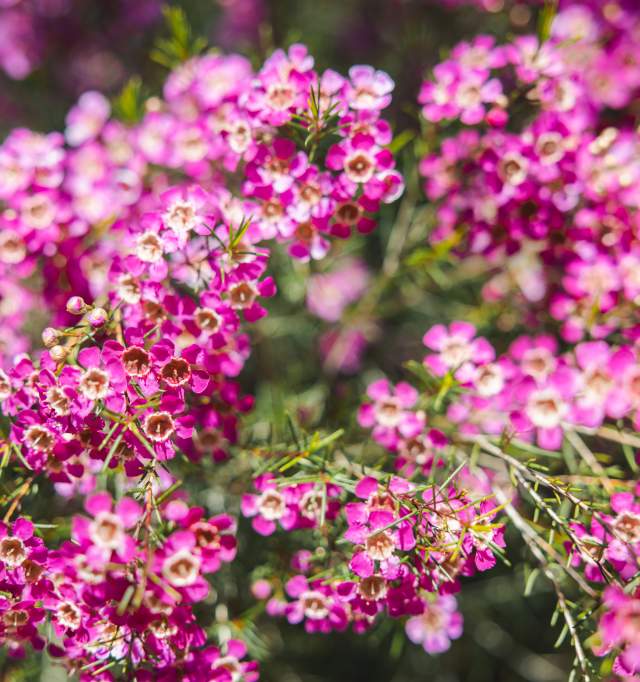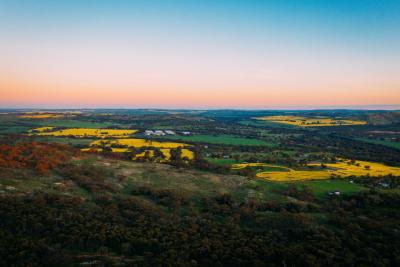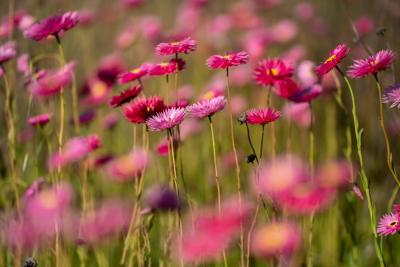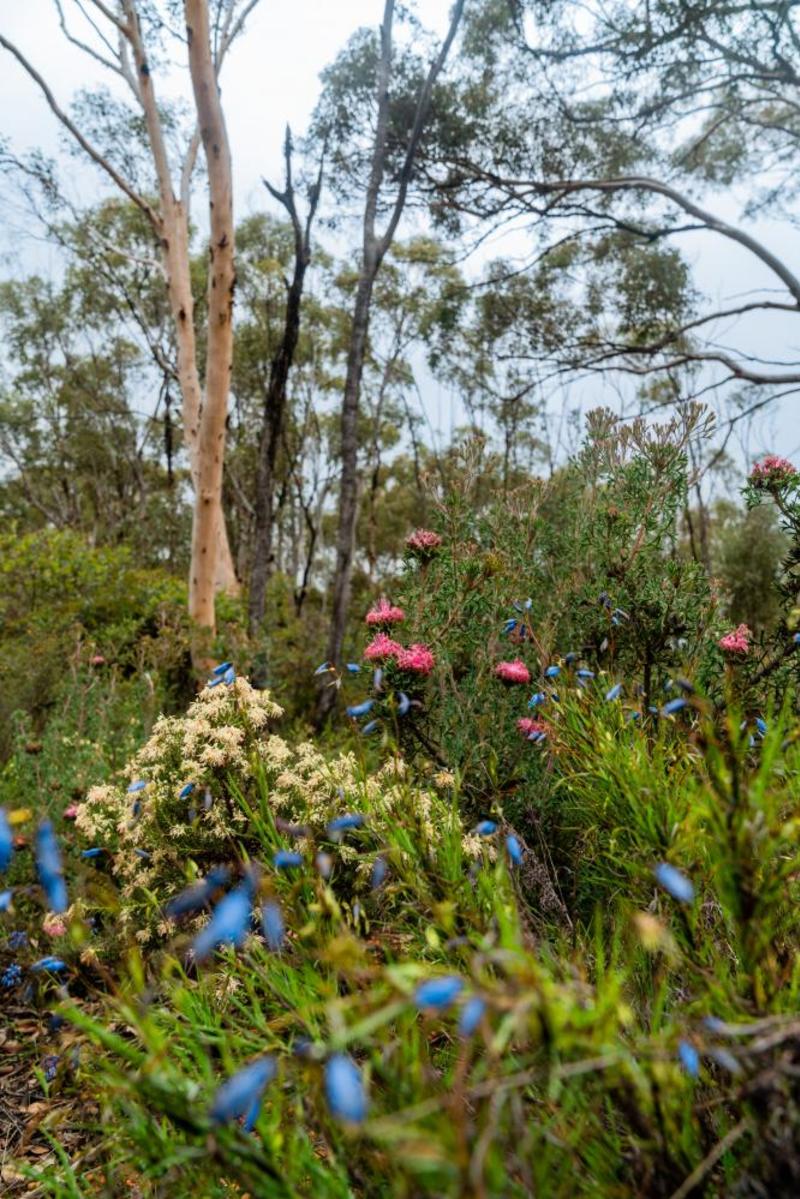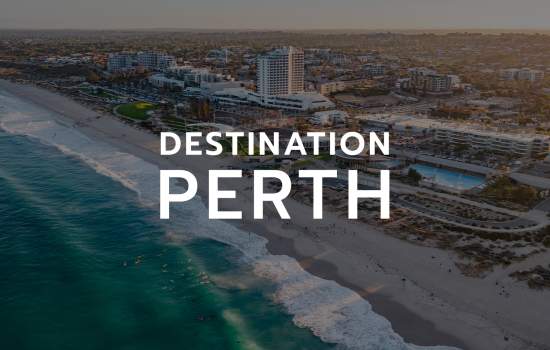WA's Wildflower Country: 7 Day Self-Drive Road Trip
Western Australia is home to one of the largest wildflower collections on Earth.
The wildflower season begins in late August and continues until early October, replacing red dirt, rugged rocky outcrops, wild woodland and coastlines with dustings of colour and abundance.
This epic seven-day, self-drive road trip begins in Perth before traversing Australia's Coral Coast, where you'll explore the wildflower blanketed terrain at Coalseam Conservation Park enroute north to Kalbarri. In Kalbarri, journey through coastal cliffs and the inland red banded gorges of Kalbarri National Park.
You’ll then take the roads less travelled around Australia's Golden Outback, with a station stay, rustic dining and a Monster Truck wildflower experience. Say no more!
And finally, back to Perth, through the charming, culture-rich country towns of the Avon Valley, before a wander through the wildflowers at Wongamine Nature Reserve and the purpose planted everlasting and canola fields. You'll have the opportunity to channel all things sophistication, while you sip on delicious wines and indulge in culinary genius while learning the history behind the venues.
Over 60 per cent of the more than 12,000 wildflower species found in WA are unique to the area, so take this as your sign to get out there and explore! Pack the car, fill the tank and hit the road. Check out the itinerary below.
Day 1: Perth + Pinnacles + Dongara + Mingenew + Kalbarri (571km | 6.5 hours)
Perth - Pinnacles (2 hours)
Sunrise at the Pinnacles
Rise early to hit the road and catch sunrise at the Pinnacles. You'll see the hundreds of limestone structures - some of which stand 3.5 meters high – that formed approximately 25,000 to 30,000 years ago to create the Pinnacles Desert at Nambung National Park.
The eerie, mars-like location is the home of many native animals and birdlife. If you’re a budding photographer or partial to a gram photo op, sunrise really and truly is the best time to visit for the incredible shadows and morning light!
Pinnacles - Dongara (2 hours)
Dongara
Arrive in the coastal twin-town of Dongara-Port Denison for a half day wildflower tour with New Leaf Connect, who offer personalised custom and full day tours of the Coalseam and northern (Canna, Mullewa and Pindar) or southern surrounds (Mingenew, Three Springs and Morawa). They are all about creating connections between people, places and produce across the Midwest. They take away the leg work of planning, so you can focus on the fun part.
On the tour, you’ll visit biodiversity hotspot and historically significant Depot Hill, before a lunch stop at Mingenew Bakery and a visit to the wildflower carpeted Coalseam Conservation Park.
Depot Hill
Located a zippy five minutes from Mingenew, Depot Hill is an orchid hotspot abundant in life and history. If you’re partial to a walk, take the bush track to discover the Army Rifle Range which was used as an army training area during World War II.
You’ll even find a remaining bunker if you follow the walking trail through the reserve. Word on the street is that the other bunkers were dismantled and the stone was used for the construction of septic systems in the town. You’ll also find an abundance of cowslips and other popular wildflowers.
Coalseam Conservation Park
Located halfway between Mullewa and Mingenew on Coalseam Road, the park is famous for the effervescent carpets of yellow, cream and pink pom-pom everlastings that cover the red soil, rocky outcrops and rugged cliff terrain. Coalseam is not only rich in natural beauty, but also in history as it was the location of WA’s first mined coal deposit.
The exposed bands of coal seam, claystone, siltstone and sandstone reveal 250 million years of ecological history. The park is also home to a collection of walking trails and lookouts, dotted with information detailing the native flora and fauna.
Mingenew - Kalbarri (2.5 hours)
Stay: Kalbarri Edge Resort
A day of exploration calls for a night of rest and recuperation. Located in the heart of town, a stone’s throw from the ocean and pub, the Kalbarri Edge Resort is the perfect place to wind down and relax. There’s a restaurant on-site or hit the pub down the road!
Day 2: Kalbarri
Home to the exquisite Kalbarri National Park and dramatic Coastal Cliffs, the laidback coastal town of Kalbarri is a great place to visit for a little wildflower eye candy.
Birgurda Trail
Begin the day with the 8-kilometre Birgurda Trial that traces the breathtaking Coastal Cliff stretch between Eagle Gorge and Natural Bridge. The moderately easy walk atop the multi-coloured layers of sandstone and limestone hugs the Indian Ocean, and features steep chasms, rocky inlets and mesmerising rock formations. You’ll see bursts of colour as wildflowers bloom and if you might even spot the migrating whales.
Enjoy lunch at The Gorges Cafe.
Kalbarri National Park & Wildflower Tour
Jump on a wildflower tour in Kalbarri National Park with D'Guy Charters. You’ll come for the inside scoop on Guy’s local knowledge of the region and wildflowers and you’ll stay for the humour. D’Guy Charters also offer Stargazing Tours at the Kalbarri Skywalk for those starry night sky enthusiasts.
Traversing an impressive 186,000 hectares, the Kalbarri National Park resides at the lower reaches of the Murchison River – WA’s second longest river which flows for about 820 kilometres. A myriad of unique wildflowers bloom among the National Park’s gorges and coastal cliffs. You’ll also be sure to see pops of colour when visiting the Insta-famous Nature’s Window lookout and Z-Bend Gorge.
All roads within the park are sealed and suitable for 2WD vehicles. Western access to the park is from the town of Kalbarri, via Ajana-Kalbarri Road and eastern access is off the North West Coastal Highway, via Ajana-Kalbarri Road.
Stay: Kalbarri Edge Resort

Kalbarri Skywalk | Kalbarri
Day 3: Kalbarri + Mullewa + Mellenbye Station (340km, 4 hours)
Today you’ll make your way from the coastal cliffs of Kalbarri to the charmingly rugged Mellenbye Station, stopping in Mullewa for lunch along the way.
Mid-West Wildflower Country
Wildflower Country runs from Moora in the south to Dalwallinu in the east, and from Mullewa in the north to Green Head and Geraldton in the West. WA’s Wildflower Country is the collective name given to inland farming towns located a few hours north of Perth, including Carnamah, Coorow, Dalwallinu, Mullewa, Moora, Morawa, Mingenew, Perenjori and Three Springs. Not only do these small towns boast incredible displays of wildflowers, there’s also a lot of history and heritage woven into their roots.
Kalbarri to Mullewa (2.5 hours)
Mullewa
About 100 kilometres east of Geraldton, Mullewa is known for its mesmerising carpets of everlastings and as one of the few places in the world where the wreath flower (Wreath Leschenaultia) grows. The town is also home to the annual Wildflower Show in September. The floral richness of the region is due to the town straddling both geological and climatic transition zones, which creates diversity across varying soil types and rainfall and temperature zones.
Enjoy lunch at Mullewa Wildflower Cafe.
Mullewa - Mellenbye Station (1.5 hours)
Mellenbye Station
Mellenbye Station is a place of fresh air, wide open spaces, wildflowers and the most perfect starry night skies. Keep your eyes peeled for the wreath flowers dotted around the station entrance and within the paddocks. They aren’t easily found, so a hot tip is to check in with the station owner, Shelley, before you set off on your hunt as she may be able to provide the inside scoop on where to look or she might even provide a tour.
The station located in the Yalgoo-Morawa area gives visitors the complete Aussie outback experience, from Monster Truck rides to a shearing shed fitted with a mini library and karaoke machine.
It’s like a Choose Your Own Adventure novel because you have a range of accommodation options to choose from, including cottages, cabins, donga-style rooms, glamping pods, homestead rooms, camping and caravanning, so there’s something for all tastes and preferences.
Wollanoo Rock
Station-goers also have the opportunity to embark on a free guided tour to Wollanoo Rock, based on the availability of staff. At the spectacular granite outcrop fondly known as “The Rock,” you’ll spot everlastings, donkey orchids, Mellenbye bottlebrush and station cattle. You should also take the short walk to the top for expansive views over the station.
Monster Truck Experience
Make sure you opt for the thrilling experience on the resident, station-owned Monster Truck out to the stunning Burra Lake! You’ll be buzzing with adrenaline while you’re taking in the spectacular outback views. This tour is based on the availability of staff.
Stay: Mellenbye Station
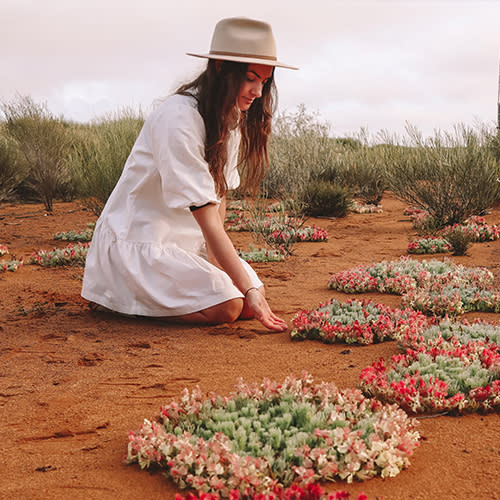
Mellenbye Station | Yalgoo
Day 4: Mellenbye Station + Perenjori + Dalwallinu (206km, 2.5 hours)
There are camp kitchens available to cook up a storm, so you can enjoy a feast in the intricately decorated shearing shed. Then jump in the car and head towards Perenjori for some more wildflower exploration. You’ll visit the historic John Forrest Lookout and Camel Soak before feasting on a parmi at the pub and spending the night in Dalwallinu.
Mellenbye Station - Perenjori (1.25hrs)
Perenjori
Situated 350 kilometres from Perth and 39 kilometres south east of Morawa, with a population of 617 people, Perenjori is one of the nine towns that combine to create WA’s Wildflower Country. The name comes from the Aboriginal word “Perangary,” meaning water hole and it’s also part of the “Wildflower Way Tourist Drive” that runs from Dalwallinu to Geraldton.
Bird lovers should keep their eyes and ears peeled as the farming town surrounded by all things sheep and wheat is famous for its impressive collection of native birds. Parrots, cockatoos and water birds are common in the area, as well as honeyeaters, thornbills, babblers and fairy-wrens.
Another notable Perenjori attraction is the Church of St Joseph which is one of a momentous collection of church buildings, designed and built by Monsignor John Hawes throughout the Midwest and Murchison. He is also behind the St Francis Xavier Cathedral in Geraldton and numerous other buildings in the UK, USA and Bahamas.
John Forrest Lookout
Venture through pastoral and mining country to the John Forrest Lookout which forms part of the Perenjori-Rothsay Heritage Trail. The trail is a 180-kilometre round trip which encapsulates the Perenjori Museum (originally the Bank of NSW building), Rothsay townsite, famed rabbit-proof fence road to Camel Soak and Monger’s Lake Lookout (an Aboriginal heritage site, which tradition says was formed by the Bimurra creator being).
Witness the dreamy fields of gold, pink and white everlastings as far as the eye can see at John Forrest Lookout. You might even see the Centaurea cyanus, commonly known as the cornflower or bachelor’s button.
Australian explorer and first Premier of Western Australia, Sir John Forrest established his survey at the top of this hill which was later named in his honour during an expedition in 1897. The steep 750-meter climb to the lookout is well worth the leg work for the 360-degree panoramic views at the top. You’ll be rewarded with expansive sights of surrounding farmland and station country.
Picnic facilities and toilets can be found at the base of the hill. The lookout is located about 45 minutes east of Perenjori, along Perenjori-Rothsay Road.
Camel Soak
Journey to Camel Soak, the man-made waterhole nestled within a granite outcrop also known as “The Rock Hole”.
As the name suggests, the location 47 kilometres east of Perenjori, was once used as a water source for men and their camels during the building of the Rabbit Proof Fence in the early 1900s. The fence stretched 1,827 kilometres from the south of the State to the north and near was devised as an attempt to inhibit rabbits from entering WA’s agricultural areas.
Kangaroos and emus are regular visitors of the beautiful pools along with an abundance of birdlife, so don’t forget your binoculars! The rock formations are also home to an array of orchids, which can be found at the base of the rock. The tranquil scenery makes the destination is a popular picnic spot, so plan ahead and bring a tasty spread to enjoy.
Perenjori - to Dalwallinu (1.5 hours)
Dalwallinu
The first Europeans explored the area in 1907, the first settlers arrived two years later and the first crops were planted in 1910. Since then, a heritage of sheep and wheat farming has been woven into the roots of Dalwallinu.
The town is known for their magnificent Wattle trees and world-famous tourist route, Wildflower Way. And for the eight types of parmi’s served at the local pub!
Dalwallinu - Petrudor Rocks (30 minutes)
Petrudor Rocks
Petrudor Rocks is an enormous granite outcrop with water holes at the base. It’s a wonderful place to stop for a picnic or drink as you watch the sun go down, and a great place to see wildflowers and native fauna in season.
The adored pink and white everlastings are among the collection of wildflowers peppered around the reserve. Others include wattles, native grevilleas, kunzea pulchella (native bottlebrush) and other species of bottlebrush. Donkey orchids, spider orchids, blue fairy orchids and leek orchids can also be found at the top of the rocks, and around the perimeter.
Dinner: Dalwallinu Hotel
Thursday night is parmi night! And with eight different types begging to be devoured, it would be rude not to! The pub also features a wildflower room which is aptly decorated with flora, where guests can dine and enjoy the colours of the season while indulging in a hearty feed.
Stay: The Old Convent, Dalwallinu
The story of The Old Convent began in 1923, when one of the pioneering families of the district built the structure as a private residence. Since then, the building operated as a unisex Catholic day school, all girls boarding facility and Catholic Church before it was renovated and refurbished to become tourist accommodation.
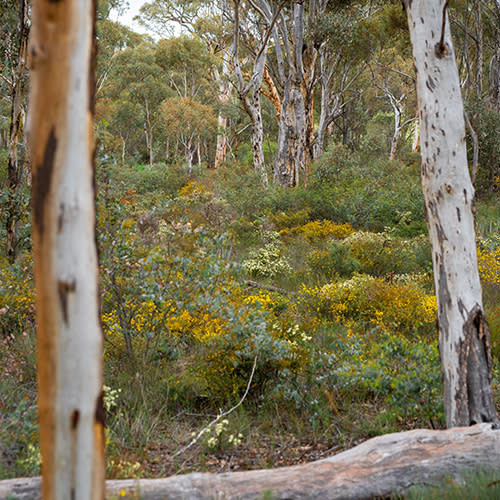
Wongamine Nature Reserve | Toodyay
Day 5: Dalwallinu + Wongan Hills + Toodyay (173km, 2 hours)
Enjoy the complimentary continental brekkie at The Old Convent, before packing up and heading to Wongan Hills. You’ll then make your way to Toodyay for an overnight stay, after a day spent exploring a magical reserve and wine tasting.
Dalwallinu - Wongan Hills (1 hour)
Wongan Hills
Wongan Hills is home to the largest area of natural vegetation remaining in the northern wheatbelt. It’s also a place of diverse flora, boasting more than 250 species of flowering plants. The name comes from the Aboriginal word meaning “whispering hills”.
Wildflower Tour with Rod Clark
Tee up a trip with local wildflower enthusiast Rod Clark, who is always happy to take fellow wildflower fanatics into the bush for a free wildflower tour through an area the locals fondly call “paradise”. You’ll spot spider, donkey and cowslip orchards, as well as the lemon-scented sun orchard and blue fairy orchard. Visitors can get in touch through the local Visitor Centre to book a tour.
Wongan Hills - Toodyay (1 hour)
The picturesque Avon Valley town is one of the oldest inland settlements in WA. Only 80 kilometres north-east of Perth, Toodyay features charming displays of 19th century history, with the architecture reminiscent of its colonial and convict past. During the years of 1860 and 1910, the town was known as Newcastle. This caused problems as mail was accidentally being delivered to Newcastle in New South Wales. The name was then changed to Toodyay, which comes from “Dudja,” the Noongar word meaning place of mist and fog.
The Shire is unique as it’s within the three Noongar Boodja boundaries of the Ballardong, Yued and Whadjuk people. Toodyay is also a hidden treasure for those with a taste for history, as it oozes stories of bushrangers, convicts and war heroes. Think the infamous Moondyne Joe for starters! Pink everlastings, blue leschenaultia and a variety of orchids can all be found during the wildflower season at popular locations including Pelham Reserve, Dawn Atwell Reserve, Wongamine Reserve and Majestic Heights.
Lunch: Toodyay Bakery
Home to award winning pies, sausage rolls, and apple pies, this bakery will surely be a highlight of the trip. Order away and make your way upstairs, where views of the town and main street can keep you entertained for hours.
Wongamine Reserve
The Shire of Toodyay offers an abundance of opportunities to reconnect with nature as it’s home to a number of picturesque reserves. Located 17 kilometres from the town of Toodyay, Wongamine Reserve spans 330 hectares and features a collection of medium difficulty tracks, including a 6.5-kilometre perimeter walk and three smaller trails.
Salmon Gums are among the reserve’s varied vegetation, coupled with the Mottlecah which has the largest Eucalypt flower in the world and an array of orchid species. The most common wildflower in Toodyay is the bright yellow Acacia Acuminata, which is also the unofficial emblem of the shire.
Historically, the reserve served as a watering/stopping place, and for timber and gravel extraction but is now used for conservation purposes. You can park along Bejoording or Forest Road which is a designated flora road set aside to highlight the diversity of the flora in the area.
Wine Tasting: Coorinja Winery
Only 5-minutes from the town centre, nestled in the undulating Toodyay hills, Coorinja Winery is the perfect place for a wine tasting. You’ll walk into the building and engraved onto the roof, walls and wine barrels of the century old wood are names of people from years past.
Coorinja Winery is one of the state’s oldest wineries, having been in operation since the 1870s. Over 100 years of tradition and expertise has been handed down through five generations of Wood family winemakers, since they began growing grapes in 1919. They specialise in fortified wines and have recently started producing small batch red wines.
The historic Ringa Bridge (which was built in 1888 to enable the development of the agriculture in the area) is also located on the property. Just a short walk from the winery, it’s a gorgeous spot for a picnic, so be sure to take the opportunity to visit.
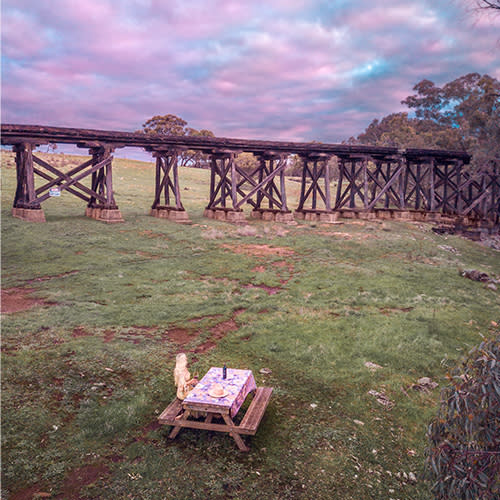
Coorinja Winery - Ringa Bridge | Toodyay
Stay & Dinner: The Victoria Hotel
The Victoria Hotel was established in the heart of Toodyay in 1888. It has undergone recent refurbishments with the addition of modern units boasting views of the Avon River – famously known for the white-water Avon Descent. The on-site restaurant is also a great place for a bite, a convenient toddle from the accommodation.
Day 6: Toodyay + Northam + York (63km, 1 hour)
Today, you’ll depart Toodyay for a historical and cultural adventure in Northam, before hitting the road again for York. In WA’s oldest inland town, you’ll visit the bushland gardens and exquisite Mount Brown Lookout for sunset, before spending an evening in luxury at Laurelville Manor.
Toodyay - Northam (20 minutes)
Nestled in the heart of the Avon Valley and located just over an hour from Perth, Northam is a destination known for a diverse collection of tourist and heritage attractions including hot air ballooning, wildflowers and horse racing. Northam also hosts a range of national and world ballooning championships and the start of the annual Avon Descent.
Visit the Avon River which flows through the town and is home to ample of bird life, including the white swan. The pedestrian suspension bridge is a great viewing area.
Enjoy breakfast at The Farmers Hotel
Bilya Koort Boodja Centre for Nyoongar Culture & Environmental Knowledge
Visit the Bilya Koort Boodja Centre which offers an interactive educational experience that highlights and celebrates the rich Aboriginal history and presence in the Nyoongar Ballardong region. Located on the foreshore of the Avon River, the cultural centre is a must for visitors to Northam.
Northam - York (30 minutes)
York
York is considered a Heritage Precinct due to the number of historic buildings scattered throughout the town. It was initially established to grow cereal crops to feed the Swan River Settlement in 1829. York is also WA’s oldest inland town, home to natural beauty, several Heritage Walking Trails and a charming country experience infused with adventure, wildflowers, good food, wine and a budding arts scene.
York Bushland Gardens
Established in 2004 for the enjoyment of the community and to showcase Western Australia’s waterwise flora, the York Bushland Gardens is the habitat of many rare and native flora, with a large emphasis on wheatbelt and southwest species.
When you visit, you’ll learn the site was once used as a clay put for brickmaking and as a disposal area for a hotel destroyed during the Meckering earthquake in the 1960s.
Mount Brown Lookout
Pack a picnic and watch the sun go down with spectacular 360-degree panoramic views of York and its surrounds at the Mount Brown Lookout. Located within five minutes of town and 342 metres above sea level, the lookout is accessible by foot or vehicle.

Mount Brown Lookout | York
Dinner: The Imperial Homestead
Enjoy dinner at the Imperial Homestead, which was built in 1886 during the Gold Rush. Choose from the fusion of pub classics and modern Australian cuisine on the seasonal menu.
Stay: Laurelville
Spend the evening at the oh, so sophisticated Laurelville Manor to end the trip with a teeny taste of luxury. The Edwardian two storey homestead was initially built in 1896 and features wide bullnosed verandas, elegant turrets and nine beautifully furnished rooms, surrounded by a garden of over 500 rose bushes. Nestled on three acres, the home belonged to the Marwick family for six generations.
Day 7: York + Perth (98km, 1.5 hours)
Enjoy brekkie at Laurelville, before packing up and heading to back to Perth.
Breakfast: Laurelville Manor
Enjoy a complimentary and individualised breakfast of fresh and poached fruits, gourmet muesli, yogurt, juices and fresh eggs and breads served by Laurelville hosts, Phil and Sandra. Trust us, you won’t want to miss this.
Depart York to Perth (1.5 hours)
Tips for Visiting & Photographing the Wildflowers
- Remember to follow the ‘Leave No Trace’ principles when visiting the wildflowers.
- It’s illegal to pick the wildflowers, and fines apply. Look, but don’t touch!
- Stick to the paths to avoid trampling the wildflowers. Some are pretty tiny, so watch your toes!
- Take nothing but photos.
- Stick to public property. Though it may be tempting to enter private fields, it’s trespassing. It’s important for tourists to stick to public areas to avoid causing damage. Canola-field-fanatics, we’re looking at you.
- Make use of the local Visitors Centres by calling ahead or dropping in. They are a wealth of knowledge and will be able to give you all the up-to-date information.
- Plan in advance as accommodation can be limited during the busy wildflower period.
- Leave it to the experts and join a wildflower tour to take the leg work out of planning your trip.
Itineraries
There's nothing like taking a drive to explore a city and it's surrounds - you'll find so much to see along the way, and even somewhere to spend the night.
